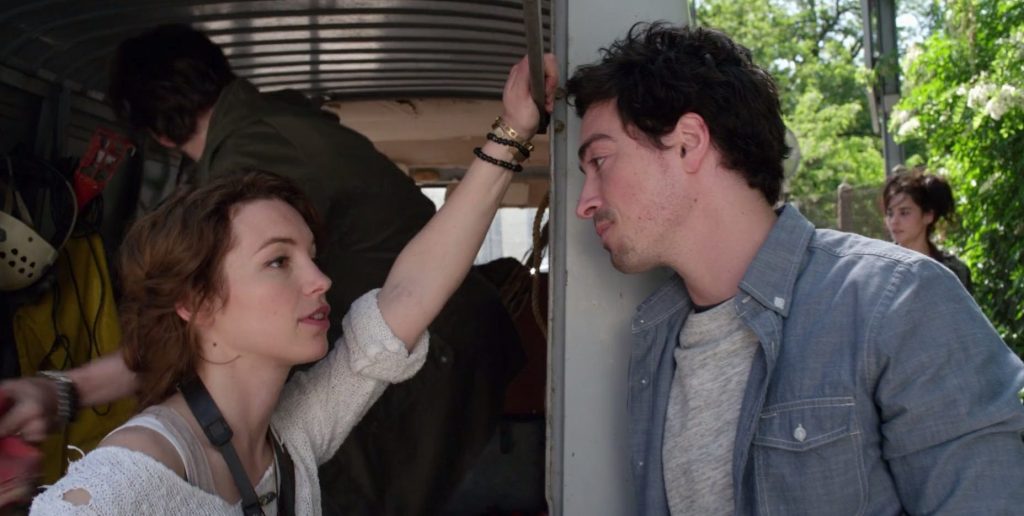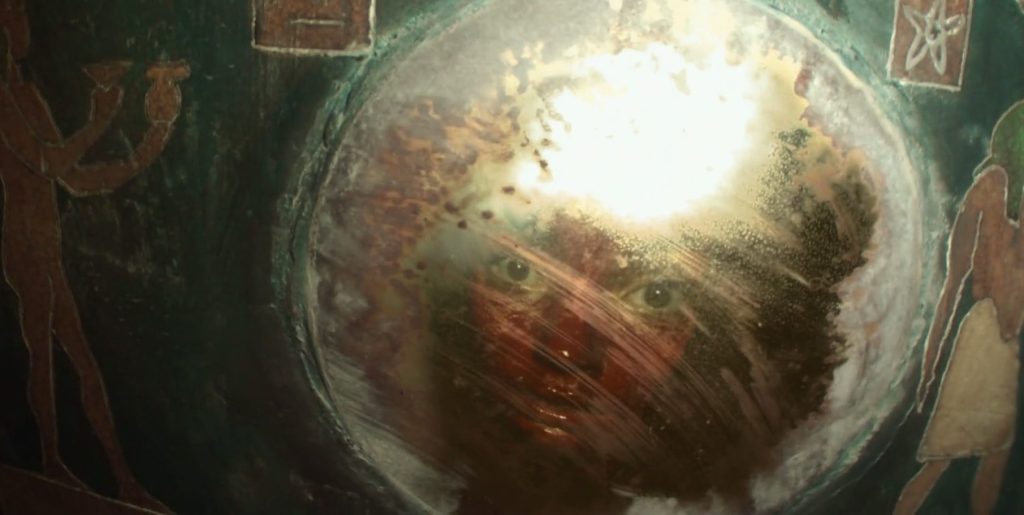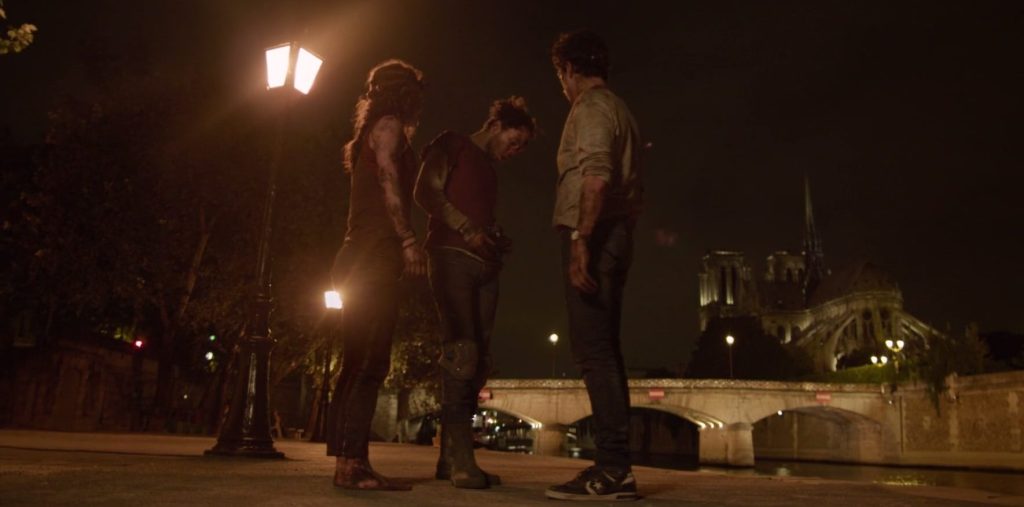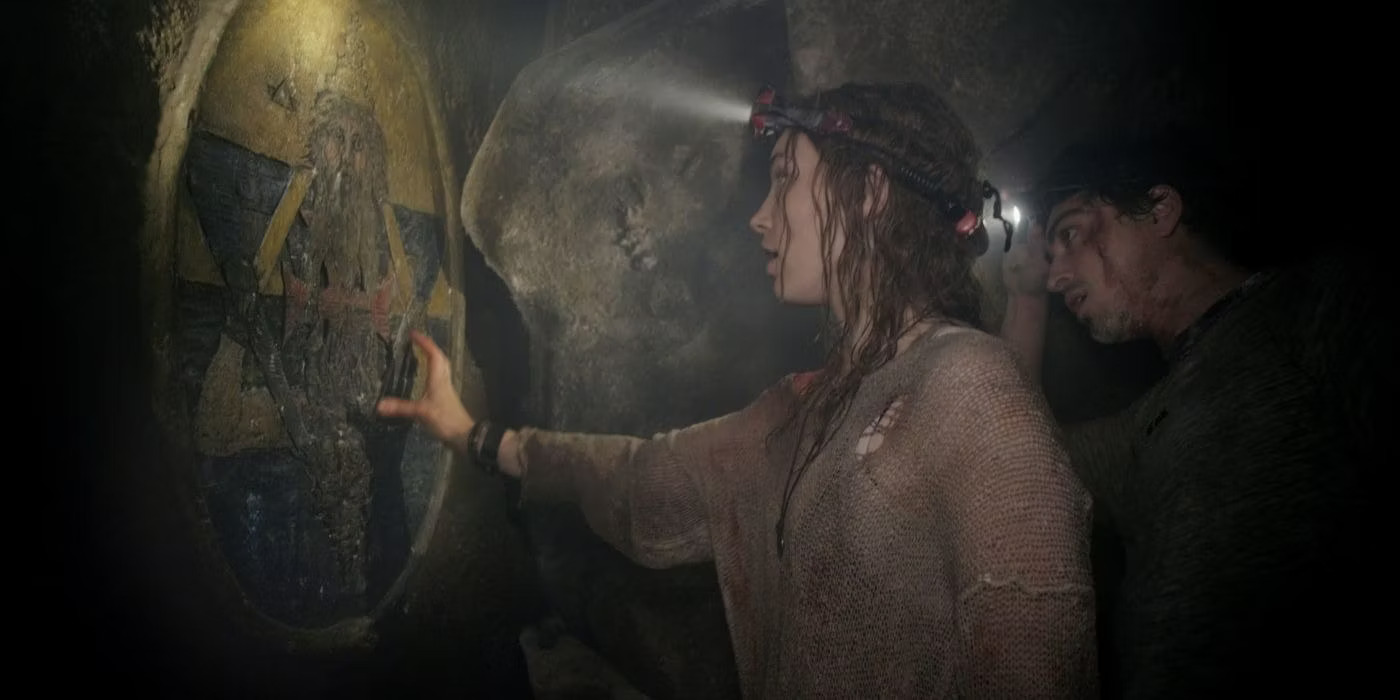‘As Above, So Below’ is a found footage horror movie following the exploits of Scarlett Marlowe, an academician who is obsessed with finding the Philosopher’s Stone, a rare alchemical artifact touted by many to turn base metals into gold or silver and grant immortality. After gathering a team of people, Scarlett descends into the catacombs of Paris, where she and her crew run into a whole array of inexplicable supernatural events that force them into a battle for survival. Things turn even more harrowing by the time the movie’s ending rolls around as Scarlett scrambles to make sense of her search and save her team members.
The film’s storyline touches upon themes of purgatory and Hell, finding parallels between the crew’s journey into the depths of Paris and a descent into the dark abyss of Hell. With each step taking them further into the labyrinthine corridors of the mysterious underground, a sense of ominous foreboding follows each member. The conclusion of this religiously inspired tale of dark demonic forces ends with a bang as the protagonist realizes her calling and what she has to do to ensure everyone’s survival. However, it does not come without a series of chilling encounters first! SPOILERS AHEAD.
As Above, So Below Plot Synopsis
Scarlett Marlowe is a talented young archaeologist on the trail of hunting down a lead to the infamous Philosopher’s Stone in a cave in Iran. After discovering an artifact inside the cave, Scarlett is assaulted by visions of a hanged man. Subsequently, the cave starts collapsing due to a demolition job. Scarlett travels to Paris with her cameraman, Benji, who is filming a documentary about her search for the Philosopher’s Stone. Scarlett believes that the Stone is hidden somewhere in the city, which also houses the estate of the dead alchemist Nicolas Flamel, the discoverer of the Stone. After a brief investigation, the archaeologist finds out that the artifact is hidden underneath the city’s foundations, lying in wait in the catacombs of Paris.

Desperate to find the treasure, Scarlett assembles a motley crew made up of her ex-boyfriend George, Benji, a local cataphile named Papillon, his girlfriend Souxie, and his friend Zed. The six descend into the dark corridors of the city’s underground resting place through a less frequented entrance. Soon after, they run into a group of female cultists, who are headed by a woman Benji ran into when they met Papillon for the first time at a nightclub. The team ignores them and forges ahead, looking to enter the deeper part of the catacombs. They venture through a mysterious entrance purported to be a dangerous section of the catacombs. Upon entering, the crew runs into La Taupe, a ghost lurking in the shadows of the dark tunnels.
La Taupe tells the crew to head further into the catacombs if they want to find a way out. Left with no choice, Scarlett follows his advice and lands in a mysterious room with treasures. She finds the Philosopher’s Stone in the room, but it collapses when the group triggers a trap while trying to take the treasure for themselves. Eventually, the crew comes across a mysterious opening on the floor that leads them even deeper into the bowels of the Earth. After traversing through the dark tunnels, they emerge in an upside-down version of the treasure room from before. Unable to understand the new surroundings, the crew feels relieved when La Taupe makes an entrance, hoping he has some answers. However, their faith is mistaken as La Taupe kills Souxie, Papillon’s girlfriend, leaving the team to flee in fear.
As Above, So Below Ending: Is the Paris Catacombs an Entrance to Hell?
One of the key plot twists in ‘As Above, So Below’ revolves around the crew’s journey into the catacombs and its parallels with Dante’s journey through the nine circles of Hell in Dante’s ‘Inferno.’ After venturing through the mysterious entrance where La Taupe is said to have disappeared, the group finds themselves lost in a more ethereal part of the catacombs that are disconnected from the rest. Essentially, this part of their journey is likely a metaphorical representation of Hell and the various tests it throws up for each member. To that end, several hints are provided to allude to the fact that they are stuck in the realm of the dead. From dark apparitions to demonic forces to ghosts, Sarah and her team have their work cut out in making sense of their surroundings.

The first real clue is presented through the Greek inscription, “Abandon all hope, ye who enter here,” which is the same message Dante encountered before he stepped through the Gates of Hell. In his poem, Dante is also guided through the various stages of Hell by Virgil, an ancient Roman poet. Similarly, the group in the film is aided on their quest by the ghost of La Taupe, who seems to be their guide through the different phases of the catacomb journey. Furthermore, the group also moves through the different circles of Hell, encountering various apparitions and forces that test their fortitude and guilty conscience. The intensity and obstacles of their trek keep mounting the deeper they venture in, as it is the only way for them to escape the place.
Therefore, after Souxie’s death, the crew keeps forging ahead despite her tragic loss. Eventually, they run into an apparition, one of a woman holding a child in her arms. Although it is not clearly stated, she is connected to Benji’s sins, as each member’s inadequacies and failures are represented through the nine circles of Hell. The woman pushes Benji to his death while the other crew members pick up his camera and keep moving forward. A second apparition makes itself known when Papillon is visited by visions of a man burning in a car. The burning man is depicted as his friend, whom Papillon left to die. He gets sucked into the car, which implodes and buries him in the ground, with his feet sticking out. It resembles another moment from Dante’s ‘Inferno.’
What Happens to the Philosopher’s Stone?
Another central mystery pivotal to the movie’s narrative is the hunt for the Philosopher’s Stone, which drives Scarlett into the catacombs in the first place. Halfway through the narrative, it seems as if Scarlett has accomplished her goals when she recovers the Stone from the treasure room. She also confirms its magical powers by using it to heal Souxie’s wound after she gets hurt when one of the caves collapses. However, as the narrative moves along, it soon becomes clear that the Stone in her possession is not what she thinks it is. Following Papillon’s death, Scarlett’s ex-boyfriend George is injured by a stone statue. When she uses the Stone to heal him, it does not do what she hopes for. Eventually, she realizes that the Philosopher’s Stone she picked up is a fake one, and she has to find the real thing.

She travels back to the treasure room, wading through tunnels full of blood and other demonic faces. Upon reaching the destination, she looks into a mirror and realizes that the real power of the Philosopher’s Stone is within herself already. However, to unlock it, she first has to confront her sins, which is where she understands the mechanics of the catacombs and how she can escape the place. The same hanged man that appeared to her in the cave in Iran materializes in front of her again. At this point, it is revealed that the man is actually Scarlett’s father, who took his own life and left her with a guilty conscience. Scarlett comes clean about her sin, which boils down to her guilt of not picking up her father’s phone the night he passed away.
Having confessed, Scarlett emerges out of the cave with the powers of the Philosopher’s Stone. She subsequently uses it to heal George by kissing him. Thus, as the power of the Stone resides within her, it is likely that in the earlier scene, when she uses the fake one to heal Souxie’s injury, it was either the result of the power within her already or that the Stone did have some magical ability after all. The ending suggests that by going through the various trials and tribulations of the nine circles of Hell, Scarlett proves to be worthy enough to inherit the powers of the Philosopher’s Stone. Instead of it residing within an inanimate object, as suggested by legend, the movie takes a different approach by having it manifest through the protagonist’s soul.
How do Scarlett, George, and Zed Survive?
After helping revive George, the three survivors attempt to flee the demons chasing after them by running to a dark hole in the middle of the catacombs. Here, Scarlett reveals to the other two that in order for them to make their way out of the place, they have to come clean about whatever sins they have committed in the past, just as she did in the treasure room. She states that if they confess and jump through the hole, taking a proverbial leap of faith, they can make it out of the nightmarish chaos surrounding them. With no options remaining, the pair decide to follow her advice and recount their sins, albeit hesitant at first. George confesses that when he was still a child, his brother drowned, and he was unable to save him. Meanwhile, Zed comes clean about an illegitimate child he fathered that he has not taken responsibility for.

Moments after revealing their deepest and darkest secrets, the three of them jump through the hole. Miraculously, they end up surviving after landing in a tiny space with a sewer exit nearby. They climb through a manhole cover and emerge on the streets of Paris, haggardly and worn down but alive. Zed begins laughing in relief and walks away, while George and Scarlett embrace one another while rekindling some of their old romantic spark, particularly after surviving the harrowing events of their hellish trek. The movie’s final sequence shows Scarlett speaking into a log, citing that she never wanted to seek any form of treasure but was driven by a need to discern the truth.
While the crew ends up losing several people during the quest, the survival of the three means that they have undergone radical changes in their personal lives. In a sense, the trek through the catacombs is a metaphorical quest that leads the characters to reflect on their inner world and their makeup as people. Scarlett’s determination to find the Philosopher’s Stone was mostly rooted in the failings she associated with her father. However, at the end of the trip, she is able to attain some form of closure on that relationship and his death, even if it comes at the cost of the lives of others. While not everyone gets their chance to repent their sins, the movie’s religious themes revolve around the idea of coming clean about one’s guilt and not letting it rule over the psyche.
Read More: Best Horror Movies on HBO Max


You must be logged in to post a comment.